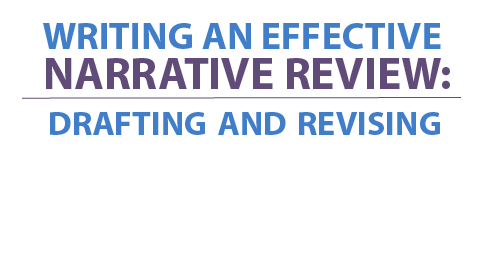- FAQs
-
Ask an Expert
Ask an Expert
Ask an expert about access to resources, publishing, grants, and more.
MD Anderson faculty and staff can also request a one-on-one consultation with a librarian or scientific editor.
- Library Calendar
-
Off Campus Login
Log in to the Library's remote access system using your MyID account.

Narrative Reviews
Before You Get Started
What is a narrative review?
A narrative review is a type of manuscript whose purpose is to summarize, synthesize, or critique the literature on a topic. Unlike a systematic review, a narrative review has very few formal constraints for selecting studies and assessing their evidence.
Check in with the journal
Before you start writing, it’s best to communicate with the editor of the target journal to establish and define the review topic. For solicited reviews, the topic should be defined in the invitation. For unsolicited reviews, it’s often a good idea to contact the editor of the target journal and ask whether your review would be welcome. Always check the journal's instructions and scope to see if reviews are accepted. Learn more about choosing a journal.
Define your approach
Determine the purpose and scope of your review. For example, your purpose might be to provide an overview of recent developments, or to interpret a group of potentially conflicting findings, or to identify promising opportunities for further research. Consider whether you intend to include summarizations of and details about individual studies, a higher-level analysis and synthesis of information, or something in between. Consider whether you are writing for fellow experts or for a broader audience in need of more explanation of your topics. Plan the depth of coverage and decide which related topics you will likely incorporate into your review.
Plan and perform a literature search
Decide what kinds of articles you will look for, considering parameters such as the study design, level of evidence, primary outcomes, and time period. Get help with literature searching.
Plan the overall structure
Once you have selected the studies you will discuss, take detailed notes on each. Group the studies according to themes or your desired structure for your review. It may help to create a table to help organize and compare studies according to their characteristics and findings. Then, outline the main points of the review.
Parts of a Narrative Review
Introduction section
The introduction section of a narrative review, which is typically just a couple paragraphs, can follow this structure:
- Establish the rationale for the review—that is, the need or gap being addressed. Include any background needed for the rationale to be understood.
- State the purpose of the review. This should flow logically from the rationale and guide the rest of the review.
The following introduction section demonstrates these elements:
"Sequence analysis of cell-free DNA (cfDNA) fragments that circulate in the blood of pregnant women, along with the translation of this method into screening for fetal chromosome abnormalities, is a success story of modern genomic medicine. In less than a decade, prenatal cfDNA testing has gone from small, proof-of-principle studies to a global transformation of prenatal care. As of late 2017, a total of 4 million to 6 million pregnant women had had DNA from their plasma analyzed to screen for fetal aneuploidy. The exponential growth of the test has been a function of the role of the biotechnology industry in its development and marketing. Here we review what has been learned from the wide-scale implementation of this testing, how it has changed prenatal clinical care, and what ethical concerns have arisen, and we speculate about what lies ahead." (From Bianchi DW et al. Sequencing of circulating cell-free DNA during pregnancy. N Engl J Med, 379: 464–473, 2018.)
Body
The techniques for writing the body of a review article include paragraphing, transitions, summarizing, paraphrasing, and synthesizing. A typical paragraph in a review focuses on a group of studies interpreted as a whole. Summarize studies by restating their main points in your own words, and paraphrase content by restating the information the original author provided in your own words. Strive to synthesize multiple ideas to build a unique perspective.
Conclusion
Write a conclusion that corresponds to the purpose of the review and is based on the presented material. The conclusion may be followed by a few sentences that emphasize areas where more research is needed.
Abstract
The abstract of a narrative review is almost always unstructured. It may include:
- The background and rationale (essential)
- The purpose statement (essential)
- Key themes or core ideas
- A conclusion
Here is an abstract that demonstrates these elements:
"Although we have come a long way in our understanding of the signals that drive cancer growth, and how these signals can be targeted, effective control of this disease remains a key scientific and medical challenge. The therapy resistance and relapse that are commonly seen are driven in large part by the inherent heterogeneity within cancers that allows drugs to effectively eliminate some, but not all, malignant cells. Here, we focus on the fundamental drivers of this heterogeneity by examining emerging evidence that shows that these traits are often controlled by the disruption of normal cell fate and aberrant adoption of stem cell signals. We discuss how undifferentiated cells are preferentially primed for transformation and often serve as the cell of origin for cancers. We also consider evidence showing that activation of stem cell programmes in cancers can lead to progression, therapy resistance and metastatic growth and that targeting these attributes may enable better control over a difficult disease." (Lytle NK et al. Stem cell fate in cancer growth, progression and therapy resistance. Nat Rev Cancer. 18: 669–680, 2018.)
Bibliography
Day RA and Gastel B. How to write a review paper. In: How to Write and Publish a Scientific Paper. 7th ed. Greenwood; 2011:147-150.
Pautasso M. Ten simple rules for writing a literature review . PLoS Computational Biology. 2013;9:e1003149.


